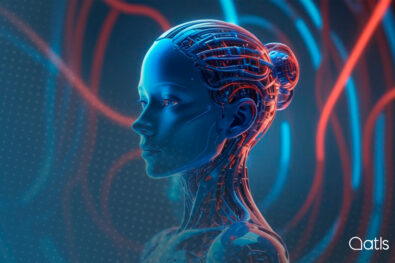What we call 'instant translation' is a set of translation techniques (text-to-text, speech-to-text, speech-to-speech, etc.) with one thing in common: automation, increasingly supported by artificial intelligence. The quality is constantly improving, but in professional translation, its status remains as a helpful tool.
The year 2024 might well be remembered as the year in which instant translation became the new normal. Meet the devices that make it possible. Can you imagine yourself, smartphone in hand, easily ordering a taxi in a far-off land? But maybe closing a contract in the same way, not so much?
Nowadays, 'immediacy' is more immediate than ever before. You can even get instant translations on WhatsApp, but it's worth remembering the cons as well as the pros of so-called instant translation - above all in professional and business settings. But first of all, it's important to clarify some concepts.
What is instant translation?
It's one of those things that's much easier to understand (and use) than explain or define: technology that enables the translation of both written and spoken materials from one language to another without any human intervention, is generally automated and immediate, and is usually supported by artificial intelligence.
Outside the translation industry, the technology has a number of names: real-time translators, live translators, speech translators... We call it instant translation or instant interpreting. On the one hand, this differentiates it from human translation, and on the other, because it covers both translation and interpreting.
Difference between instant translation and instant interpreting
Let's clarify. Let's take it from the top. Traditionally, in the translation field, the word 'translation' is used for written work, and 'interpreting' for any kind of spoken translation. These boundaries are blurring now, but in our industry, interpreters and translators still do different tasks.

Now that automation has landed in our industry, along with the ease of converting audio to text and back again, the differences between translating and interpreting are becoming less and less important to the general public. However, there are technologies that can translate (from text to text) and others that can interpret (from speech to speech), and knowing the difference between the two is important, right?
What does AI bring to instant translation?
Soooo... Generally speaking, AI contributes a lot of things to translation, and certainly not minor: immediacy, reliability, accessibility, consistency... The integration of artificial intelligence into our industry hasn't happened overnight. It's gone from the initial rule-based approach to statistical, and is now based on neuronal and hybrid approaches. It's made huge steps forward from CAT (computer assisted translation).
And although, as Wikipedia explains, machine translation without human intervention has brought about a degree of disillusion due to its naïve approach to 'high-level cognitive tasks', advances in natural language processing in AI are bringing that final frontier - contextual naturalness - ever closer.
Benefits of instant translation with AI
If we had to sum up the main advantages of instant translation, we would no doubt mention its functional effectiveness, the breadth of languages it covers and, of course, the immediacy of the translation.
High-speed, real-time translations
It's completely logical that the wider public are as confused as we said. Machine-translation processing speeds are taking us in the direction of 'simultaneous translation'; this is unprecedented in the traditional translation world, where simultaneous written translation has never been possible.
In this sense, yes you can carry a simultaneous translator or speech translator in your pocket; maybe not the right name from a more traditional perspective, but at least in practical terms (putting the limitations to one side) they offer the incredible potential to speak or write and - instantly - be able to read or hear a translation.
Broad language coverage for instant translation
Another barrier AI has smashed (at least in terms of a viable minimum service) is access to a huge range of languages. Until relatively recently, machine translation in a dozen widely spoken languages (English, French, Spanish, etc.) was relatively common; today, services like Google Translate cover almost 150 languages.
But the impact of AI is even more remarkable, with fairly effective results. And also in 'mixed' forms: instant interpreting from speech-to-text or speech-to-speech using various software solutions like voice recognition, machine translation, transcription, subtitling and speech synthesis. This software now available to all, although it will yield limited results in the professional field.

Improving operational efficiency in multilingual settings
Anyone can instantly think of numerous use cases of this technology, always in multilingual settings (an increasingly common situation): the translation of instructions, film subtitles or a simple chat between partners or employees on different sides of the world.
Basically, in most cases it's about limited, everyday or informal use. In this regard, either the tools themselves impose the limits (technical capacity), or the difficulty or importance of translation demands human supervision. But if all you really want is to 'be understood', it's pretty great.
Pitfalls of instant translation with AI
As we've said, the advantages of instant translation with AI are undeniable, but so are the disadvantages, mainly in terms of reliability and accuracy.
Live translation: limited accuracy
When you get deep into the land of legal and contractual terminology, academic content filled with complex nuances, or complex technical instructions, you need to be clear on what you're reading or listening to; and it needs to be perfectly understood. In cases like these, rigour matters. A lot.
The same goes for literature, journalism and marketing (and even international cooperation). On those occasions when every little detail matters and you need to be thorough, remember: machine translation/interpreting solutions - including AI-supported versions - make mistakes that a professional wouldn't make (and humans make other kinds of mistakes. That's part of the package; which is why a human/machine team is the ideal).
The challenge of capturing cultural and contextual nuances
This is a problem that directly affects AI in general (like the recent controversial matter of Microsoft's AI drafting headlines), and in the case of translation, it comes with an added complication: if you don't understand the two languages involved, it's almost impossible to know if you have a poor translation or not.
Among professionals, there's a fairly widespread consensus regarding the difficulties artificial intelligence faces when it comes up against ambiguous contexts, cultural sensitivities and even 'simple' (for humans) cases of polysemy and homonymy, not to mention the problematic biases stemming from training data and reference materials.
Real-time translation: dependent on technology
There's a third factor that's particularly important to consider in some settings and sectors: the total dependency on computer systems. Let's imagine an international, multilingual meeting, in which your shiny new speech (or whatever type) translator stops working; it's any organiser's worst nightmare...
There are some situations - whether due to the type of materials or the nature of the setting - in which entrusting the failure or success of your communications to a technological device just isn't acceptable (well, actually there are many, and if you're talking about multilingual simultaneous interpreting, it gets even more complex).
The Numantine figure of the interpreter
If in the year 50 BC the whole of Gaul was occupied by the Romans, apart from one irreducible village, in 2024 the entire translation industry is drenched in instant translation... apart from the interpreting specialism ('spoken translation'). Will they resist artificial intelligence - now and forever?
It's probably only a matter of time before our heroes - consecutive interpreters and simultaneous interpreters - are superseded by AI-based consecutive interpreting and simultaneous interpreting. But for the time being there they are, ready and waiting, for those times when their expertise (and humanity!) remains irreplaceable.
When does human simultaneous interpreting come into play?
The ultimate example is an international or multilingual conference (very much the natural habitat of simultaneous interpreters). Tech solutions exist that enable remote simultaneous translation, but if you want translation quality - guaranteed - the human element remains indispensable.
In any setting in which privacy is an absolute priority and sensitive information is on the cards, one thing is certain: you would be advised not to transmit or store data - neither on electronic devices nor in the cloud. What immediately springs to mind are the whisperers in bilateral political meetings.
Imagine a business meeting with representatives of two companies providing highly specialised B2B financial services - one British and one Spanish - discussing a potential merger. No CEO in their right mind would go without the services of a professional simultaneous interpreting service in English/Spanish - in human form. Would you?






